Trinity College was established in 1848 as the South Wales and Monmouthshire Training College and is the oldest surviving teacher training college in Wales. Its role was to train young men for teaching in Church primary schools and followed a strict training regime, which made the graduates perfectly suited for life in the military. It was widely known simply as Carmarthen Training College during the Great War. The students practised a wide variety of sports, but rugby was the mainstay, as it still is locally. The college later became known as Trinity College and merged with the University of Wales, Lampeter, in 2008. A large number of staff members, students and former students of the college served during the Great War of 1914-1918, and a number of these lost their lives during the conflict. The senior figure in the college during this time was the Reverend Albert William Parry, who was the Chaplain to the 4th Battalion, Welsh Regiment. A Chapel within the college is dedicated to past students and lecturers who served during the First World War. I do not have any details or photographs of any memorial in the Chapel, so have compiled the list of men killed, below, from reports in local newspapers throughout the war. If anyone has access to any photographs of a memorial there, I would be most grateful. as I would like to correct any errors and add any missing men or women.
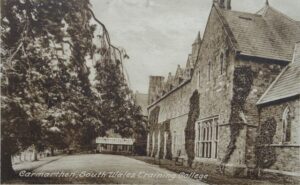
The Great War, 1914-1918
Wilfred Brash, Second Lieutenant, King’s Own (Royal Lancaster Regiment). Wilfred was the son of Richard and Mary Ann Brash, of 62, Parkfield Terrace, Lancaster. He was educated at Carmarthen Training College prior to taking up a teaching position at Lancaster. He enlisted into the King’s Own (Royal Lancaster Regiment), and served in France from 14 February 1915, rapidly gaining promotion to Sergeant. He was commissioned into the regiment on 15 July 1916, and posted to the 1st/5th Battalion, King’s Own, which was attached to 166 Brigade, 55th Division. The division had seen heavy fighting on the Somme in 1916 and relieved the 29th Division at Ypres in October 1916, taking over the Railway wood sector. Wilfred had by now taken up the post of battalion intelligence officer. During the first week of March 1917 the battalion was supplying working parties to Ypres on water supply, and also to Proven Aerodrome. On 6 March the battalion moved forward to the front at Railway Wood to relieve the 1st/6th King’s Liverpool Regiment. During the coming days the men carried out consolidation work on the waterlogged trenches, in appalling, freezing conditions. At 18.50 on 9 March 1917 a giant explosion broke the silence when the Germans fired an underground mine in between two other craters. Consolidating parties were sent out by the battalion to take over the new crater before the Germans could, but heavy fighting broke out. Wilfred was shot dead by a sniper as he led his company into the new crater that day. He was 27 years old and is buried in Vlamertinghe Military Cemetery, Belgium.
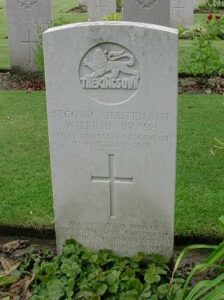
Albert Ivor Davies, Corporal, 203004, Welsh Regiment. Albert was the son of George and Sarah Davies, of Glyn Cottage, Crumlin, Mon. He had resided at Hafodyrynys, Carmarthen prior to the war, and had studied at Carmarthen Training College before becoming a schoolteacher. Albert enlisted at Carmarthen on 5 October 1912 into the 4th Battalion, Welsh Regiment, and served with the Territorials until being discharged into the regular army in 1915. Albert was then posted to Salonika to join the 1th Battalion, Welsh Regiment, known as the Cardiff Pals, which was attached to 67 Brigade, 22nd Division. The battalion had served briefly in France before embarking for Salonika on 27 October 1915. It remained in this theatre for the rest of the war, taking part in the Retreat from Serbia during December 1915. Between 10 to 18 August 1916 the division fought at the battle of Horseshoe Hill, then between 13 to 14 September 1916 at the battle of Machukovo. Between 24 and 25 April and 8 and 9 May 1917 the Division fought at the battle of Doiran, before the campaign stagnated into routine trench warfare. Albert was killed in action at Salonika on 14 June 1918, aged 25, and is buried in Doiran Military Cemetery, Greece.
John Llewelyn Davies, Major, Essex Regiment. John was born at Ferryside on 10 September 1879, the son of David Jones Davies and Catherine Davies. The family later lived in 8, Rugby Avenue, Neath. He was educated at Alderman Davies’s School, where his father was headmaster, University College, Aberystwyth, and at Emmanuel College, Cambridge. On leaving Cambridge, John went as lecturer to Carmarthen Training College for a short period, and subsequently became science master at the Perse School, Cambridge. While here me met his future wife, Isabella Christina Fraser, BA, also a teacher, and they married in August 1915 while John was on leave in her home town of Wrexham. In May 1915, John had been appointed headmaster of Cardiff High School, but instead took up a commission into the Essex Regiment, and was posted to France with the 11th Battalion, Cheshire Regiment, which was attached to 71 Brigade, 24th Division. On 30 August 1915 the battalion landed at Boulogne, and proceeded to positions at Loos. John was badly wounded during the opening assault at Loos on 25 September 1915n and died that same day, aged 36. His obituary states that he died of his wounds in hospital at Wesel, but another stated that he fell near Tower Bridge at Loos. John has no known grave, and is commemorated on the Loos Memorial, France.
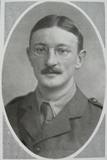
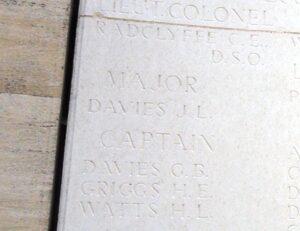
Sidney Ernest Garnsey, Private, F/3210, Middlesex Regiment. Sidney was the son of Ernest William Garnsey and Elizabeth Ann Garnsey, of 27, Parkhurst Road, Bowes Park, London. He was educated at the Stationers Company School and at Carmarthen Training College prior to becoming Assistant Master at Alexandra School, Wood Green prior to the war. He enlisted at Mill Hill into the 17th Battalion (Football), Middlesex Regiment, which was formed by a group of professional footballers in London on 12 December 1914 and moved to White City before moving to Clipstone Camp to join 100 Brigade, 33rd Division. The battalion landed at Boulogne on 18 November 1915, and the following month transferred to 6 Brigade, 2nd Division. The division was at Loos and moved to the Somme sector in the summer of 1916. In July 1916, the 17th Middlesex entrained for the Somme, and became involved in heavy fighting at Delville Wood on 27 July 1916. Sidney was killed in action during the battalions first assault on Delville Wood that day. He was 24 years old and was among a small group of four men buried on the battlefield during the day. During the post war battlefield clearances, the four graves were exhumed, with only Sidney’s being identified, and were all re-interred in A.I.F. Burial Ground, Flers, France. The battalion suffered so many casualties in two days of fighting at Delville Wood that a draft of 716 men was needed to bring it back up to strength.
Cyril Mortimer Green, Captain, Royal Sussex Regiment. Cyril was the son of Reverend Thomas Mortimer Green and Catherine Green, of Leahurst, Caergog, Aberystwyth, and was a brother-in-law to Reverend A. W. Parry, Principal of Carmarthen College. He had been educated at the University Colleges of Exeter, Carmarthen and Aberystwyth, along with his brother Hugh. Cyril a lecturer in Botany at University College, London when he was commissioned as Second Lieutenant into the 2nd Battalion, Royal Sussex Regiment from the London University O.T.C. in October 1914. Cyril served in France until he was severely wounded at Festubert on 9 May 1915, and returned home for treatment. He married Gwendoline Mitchell, of 23, Southwood Court, Golder’s Green, London, whilst on sick leave. Returning to the front, he was attached to the 16th Battalion, Royal Sussex Regiment, which was attached to 230 Brigade, 74th Division. The Division was taking part in the advance into Palestine, and had just successfully fought in the Third Battle of Gaza, when Cyril was killed in action on 6 November 1917. He was 29 years old, and is buried at Beersheba War Cemetery, Israel.
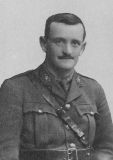
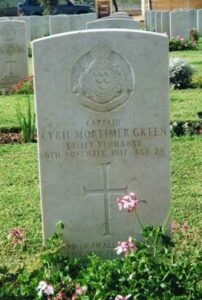
Hugh Mortimer Green, Captain, Welsh Regiment. Hugh was the son of Reverend Thomas Mortimer Green and Catherine Green, of Leahurst, Caergog, Aberystwyth, and was a brother-in-law to Reverend A. W. Parry, Principal of Carmarthen College. He was educated at Aberystwyth University and became secretary of the Diocesan Training College, Carmarthen prior to the war. He gave up his post to receive a commission into the 1/4th Battalion, Welsh Regiment, which was the local Territorial Battalion, attached to 159 Brigade, 53rd (Welsh) Division. The Division landed at Cape Helles, Gallipoli, on 9 August 1915, and was immediately thrown into action, spending the next few days in isolated pockets. Hugh was reported missing, believed killed in action, during heavy fighting on 10 August 1915 at the Battle of Sari Bair (Attack on Scimitar Hill). The 32-year-old Hugh has no known grave, and so is remembered on the Helles Memorial, Gallipoli. His brother Cyril was killed in 1917.
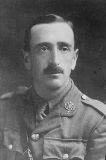
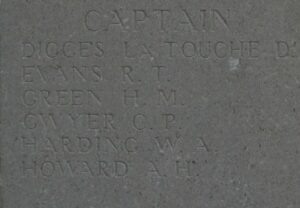
Horace William Harriman, MC, Captain, Duke of Wellington’s (West Riding Regiment). Horace was the son of Paul and Sarah Jane Harriman, of Roslyn, Coalpool Lane, Walsall, Staffs. He was educated at Queen Mary’s Grammar School and at Carmarthen Training College prior to taking up a position as assistant master at Palfrey School and at the outbreak of war enlisted into the South Staffordshire Regiment, serving on the Western Front as Company Quartermaster Sergeant from 3 March 1915. He was commissioned into the 8th Battalion, Duke of Wellington’s (West Riding Regiment) on 29 June 1915. On 9 August 1915 he was promoted to Temporary Lieutenant and attached to the 9th Battalion, West Riding Regiment, which was attached to 52nd Brigade, 17th (Northern) Division. He was awarded the Military Cross for gallantry during the Third Battle of Ypres in 1917. The citation was published in the London Gazette of 23 April 1918, and read: ‘For conspicuous gallantry and devotion to duty when in command of his company in support of another battalion. When the company in front lost all their officers and began to withdraw through his company at great personal risk, owing to heavy machine- gun fire, he stopped the withdrawal and re-established the line. Touch with the battalion on his left being lost, he made a personal reconnaissance during the night and regained touch.’ In March 1918 the Division was on the Somme, and faced the German Spring Offensive there, fighting at the Battle of St Quentin, and retreating back, fought at the First Battle of Bapaume. After a period out of the line to rest and rebuild, the Division moved to the southernmost sector of the Somme area, where it fought at the Battle of Amiens on 8 August 1918, a day which saw the war swing in the favour of the Allies. The Allies then advanced on the Somme, and the Division fought at the Battle of Albert later that month, then on to the Battle of Bapaume on 31 August, and towards the Hindenburg Line, skirting past Flers at the end of the month. Horace was killed in action north of Flers when he was hit by a machine gun bullet after he had led a successful attack. A fellow officer in his battalion wrote: ‘Captain Harriman was killed on September 1 during the afternoon, under the following circumstances: a gap having occurred between our battalion and the battalion on our right, ‘B’ Company, your son’s company, were ordered to fill the gap. The company, very gallantly led by your son, moved forward and carried out their task with great determination, capturing many prisoners and machine guns. The captured position was being organised when your son was shot by a machine gun bullet, and he died half an hour later, before he could be moved. He was buried by our Padre a day or two later, where he fell.’ Horace is buried in A.I.F. Burial Ground, Flers, France.
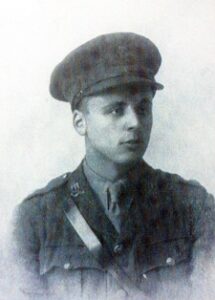
Edgar Adolphus Haselden, Second Lieutenant, West Yorkshire Regiment. Edgar was the son of George Thomas and Mary Ann Maria Haselden, of 90, Elgin Avenue, Maida Hill, London. He trained at Trinity College, Carmarthen. Edgar was commissioned into the West Yorkshire Regiment, and was promoted to Lieutenant on 1 March 1915. He was posted to France on 30 March 1916, where he joined the 11th Battalion, West Yorkshire Regiment, which was attached to 69 Brigade, 23rd Division. The Division saw its first major action at the Battle of Albert, where it captured the strongly defended village of Contalmaison. The 11th West Yorks left their billets at Coisy for Baizieux on 1 July, and on the following day marched through Albert and bivouacked for the night before relieving the 16th Royal Scots Fusiliers in trenches at Scots Redoubt on 3 July, in readiness to attack Contalmaison the following day. The assault went in during the afternoon and was initially successful, but a German counter-attack pushed the battalion back to its own lines. Edgar was wounded here on 4 July, and evacuated to the casualty clearing station at Heilly, where he died of his wounds on 11 July 1916. He was 33 years old, and is buried at Heilly Station Cemetery, Mericourt-L’Abbe, France. His battalion attacked again on 5 July but were again repelled, although 300 prisoners were taken before it was relieved on the 6th.
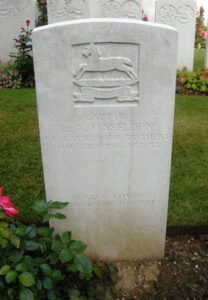
John Edwin Howells, Second Lieutenant, Tank Corps. John was the son of Thomas and Susannah Howells, of Birchgrove, Bailey Street, Mountain Ash. He was educated at Carmarthen Training College before taking up a teaching post at the Town Church School, Aberdare. During September 1914 he enlisted into the 5th Battalion, Welsh Regiment, which was attached to the 53rd (Welsh) Division and saw action in Gallipoli with the battalion from August 1915 onwards, becoming wounded. On 12 December 1916 he was commissioned into the Heavy Branch, Machine Gun Corps, which later became the Tank Corps, and by the summer of 1917 was serving with the 15th Company, E Battalion, Tank Corps on the Western Front. In November 1917 the battalion was moved to the Cambrai sector, and was attached to 152 Brigade of the 51st (Highland) Division, in order to attack a section of the Hindenburg Line near the village of Flesquières. John was in command of No 16 Tank ‘Empress II’ and was killed when his tank was hit by German artillery fire while advancing towards Flesquières Ridge on 20 November 1917. John was 25 years old when he was killed, and is buried in Ribecourt British Cemetery, France. His grave is marked by Special Memorial A. 35.
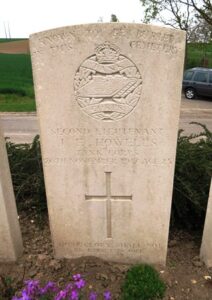
Arthur Emlyn Jenkins, Lieutenant, Machine Gun Corps. Arthur was born at Cefn Cribbwr on 18 September 1888, the son of Rees and Margaret Jenkins. The family later resided at 83, Manor Road, Manselton, Swansea. Arthur was educated at Carmarthen Training College before becoming a schoolteacher at the Hafod Schools, and was a renowned musician who had been a choir master at Cefn and Kenfig Hill before becoming the conductor of the Brynhyfryd United Choir. He married Amelia Jane Parton, a Professor of Music, at Swansea in 1915, and the couple briefly set up home at 2, Connaught Street, Port Talbot. Arthur was commissioned into the 3rd Battalion, Welsh Regiment on 6 May 1915, and on 31 August 1916 was drafted to France, joining the 20th Company, Machine Gun Corps, which was attached to 20 Brigade, 7th Division. Arthur was killed in action on the Somme on 4 December 1916, aged 28. The main battle had since been closed down, but everyday trench warfare continued to take its toll on lives. He is buried in Mailly Wood Cemetery, Mailly-Maillet, France. His brother Tudor Morgan Jenkins served as an officer with the South Wales Borderers during the war, and was wounded twice.
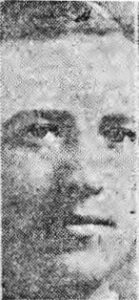
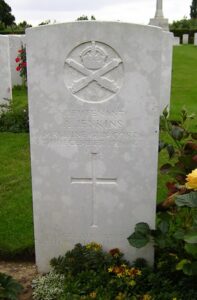
Thomas Frederick Jenkins, Major, Welsh Regiment. Thomas was the son of Tom and Louisa Jenkins, of 56, Water Street, Aberavon. He trained at Carmarthen College before taking up a position at Grangetown School, Cardiff prior to the war. He enlisted as a private but was commissioned into the 16th Battalion (Cardiff City), Welsh Regiment on 22 March 1915. The battalion was in Rhyl training then moved to Winchester as part of 115 Brigade, 38th (Welsh) Division prior to embarking for France in December 1915. The division carried out trench initiation in Flanders until marching south to the Somme sector in June 1916 and took part in the famous assault on Mametz Wood from 7 July onwards. It was relieved from the Somme sector the following month and moved to positions along the canal bank north of Ypres, where it remained for a year before launching the Battle of Pilckem Ridge on 31 July 1917. After a successful campaign at Ypres, the division wintered in the Armentieres sector, where the 16th Welsh was disbanded early in 1918. Thomas was by now a Major and was at some time afterwards attached to the 1st Army Musketry School. He survived the war but died in France on 26 February 1919, aged 36. He is buried in St. Pol British Cemetery, St. Pol-Sur-Ternoise, France.
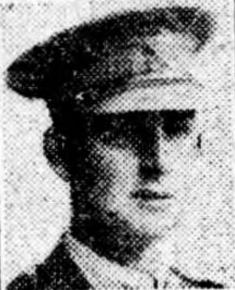
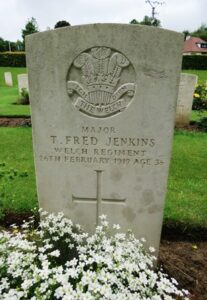
David Jones, Lieutenant, South Wales Borderers. David was the son of David and Sarah Jones, of Dolau, Dihewid, Felinfach. David had been educated at Carmarthen Training College before taking up a post as assistant teacher at Cwrtnewydd School prior to the war. He was commissioned into the 3rd Battalion, South Wales Borderers. Soon after being commissioned, David was posted to the 1st Battalion, King’s Shropshire Light Infantry, which was attached to 3 Brigade, 1st Division, probably joining the battalion in time to take part in the Third Battle of Ypres. The Division was near Estaires when the German Spring Offensive caught them in April 1918, and the Division took part in a fighting retreat, through the Battles of Estaires, Hazebrouck, and Bethune. David was killed at Ypres by a bomb dropped by a German aircraft, during a quieter spell in the trenches, on 24 July 1918. He was 28 years old, and is buried at Abeele Aerodrome Military Cemetery, Belgium.
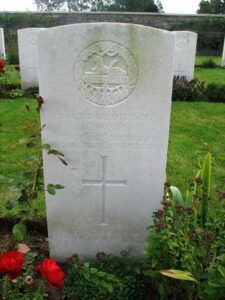
Edward Jones, Sergeant, 200808, Welsh Regiment. Edward was the son of David and Margaret Jones, of Dryslwyn Station, Llangathen. He was a student at Carmarthen College when he enlisted on 15 October 1912 into the 4th Battalion, Welsh Regiment, which was the local Territorial unit. He didn’t serve overseas, as he was deemed to be unfit, and was discharged on 23 October 1917 as being no longer physically fit for war service. Edward died of Tuberculosis at Dryslwyn on 12 January 1918, aged 28. Edward has recently (January 2012) been accepted for commemoration by the CWGC as a result of my research, and his name was to be added to the Brookwood (1914-1918) Memorial. Luckily I then managed to find that Edward was buried in Llangathen Churchyard, so the details were forwarded to the CWGC who have recently amended their records and have erected a CWGC headstone.
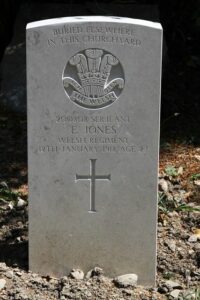
Evan Ernest Lawrence, Private, 10500, London Regiment (Artists Rifles). Ernest was born at Newport in 1888, the son of Thomas and Mary Lawrence. He had been educated at Carmarthen College, and was a School Master at Wolfscastle prior to the war, residing at Bryn Amlwg, Letterston. He married Florence Griffiths at Hill Park Baptist Chapel, Haverfordwest on 12 August 1913, and on 16 July 1915 Florence gave birth to their son, Thomas Emlyn Lawrence. Evan enlisted in London on 8 January 1917 into the 1/28th Battalion, the London Regiment (Artist’s Rifles), which formed part of the 63rd Royal Naval Division. The Artist’s Rifles were an elite Battalion, with many of their men being commissioned as Officers into other Battalions of the British Army. Ernest Died at the 1st London General Hospital of Septicaemia on 10 February 1917, and his body was brought home for burial at Letterston (Saron) Baptist Cemetery, to the right of the entrance.
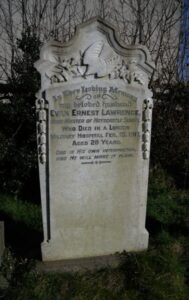
Herbert Lewis, Private, 81841, Royal Army Medical Corps. Herbert was the son of David and Anne Lewis, of Stafellwen, Llanycrwys. Herbert was studying at Carmarthen College for the Baptist Ministry prior to the war, and volunteered to serve with the Welsh Company, Royal Army Medical Corps, which was attached to the 53rd (Welsh) Division. The Division had fought at Gallipoli in 1915, then Egypt in 1916 and in Palestine in from 1917 until the armistice. Herbert was transferred to the 201st Company, Labour Corps after the cessation of hostilities, but took ill and died on 22 January 1919, aged 34. He is buried at Sarigol Military Cemetery, Kriston, Greece.
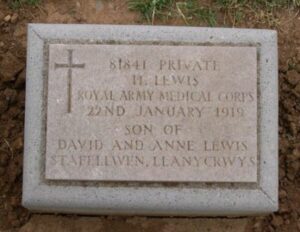
Thomas William Lewis, Second Lieutenant, Royal Welsh Fusiliers. Thomas was born on 14 May 1888, the son of Roderick and Mary Ann Lewis, of Maesglas, Efail Isaf, Llantwit-Vardre, Pontypridd, Glam. Born at Llantwit-Vardre. He had studied at Pontypridd, Carmarthen Theological College and at Hackney College before entering Cardiff University as a Ministerial Student prior to the war. He was in charges of the YMCA at Pembroke Dock when he enlisted into the 22nd Battalion, London Regiment, and on 27 March 1917 was discharged to a commission into the 1st Battalion, Royal Welsh Fusiliers. The battalion was on the Western Front attached to 22 Brigade, 7th Division and had been in action since landing at Zeebrugge on 7 October 1914. In March 1917 the division followed up the German Retreat to the Hindenburg Line, and took part in Flanking Operations Round Bullecourt. The 7th moved into a scene of incredible ferocity at Bullecourt, a strongly fortified village on the Hindenburg Line, and alongside the Australians played a major role in penetrating the village defences. Later in the year the Division moved to Ypres, and fought at the Battle of the Polygon Wood. They then took part in the Battle of Broodseinde, the Battle of Poelcapelle and the Second Battle of Passchendaele, but the 7th suffered significant losses during Third Ypres, especially in the fighting for Polygon Wood, the successful advance on 4 October east of the wood, and in the unsuccessful assault south of the Menin Road on 26 October. The 1st Royal Welsh Fusiliers had also suffered heavily on the 26th, and on the following day, 27 October 1917, were still in the front line and suffered even more losses due to continuous sniping and shell-fire. Thomas was badly wounded during the day and died soon afterwards. The 29-year-old is buried in Hooge Crater Cemetery, Belgium.
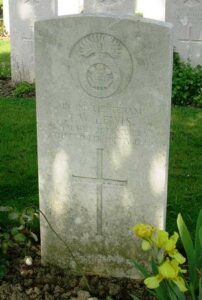
Graham Liddicott, Corporal, 105887, Royal Garrison Artillery. Graham was the son of Thomas and Mary Liddicott, of Morriston. Following his training at Carmarthen College he became a certificated schoolmaster at Morriston Boys School, and married Janet Lewis, of The Farmers Arms, Clydach, in 1906. The couple lived in 13, Ty-Gwyn Road, Clydach-on-Tawe, Swansea Valley, where their son John was born. On 3 December 1915 Graham enlisted into the Royal Garrison Artillery and after training embarked for France on 20 December that year, joining the 203rd Siege Battery, Royal Garrison Artillery. The battalion moved to the Ypres Salient in order to support the forthcoming Messines offensive, and was stationed near Kemmel when Graham was killed after a German shell crashed near to a detachment of men he was working with on 1 June 1917. Graham was 38 years old when he was killed that day and is buried in Kemmel Chateau Military Cemetery, Belgium.
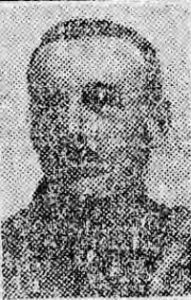
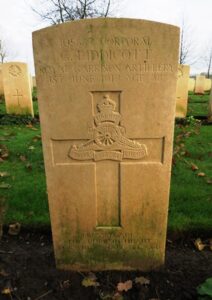
Harold Thomas Peadon, Second Lieutenant, Welsh Regiment. Harold was the only son of Joseph and Annie Peadon, of 2, Wylam Terrace, Shield Row, Stanley, Co. Durham. He was studying at Carmarthen Training College, where he became a renowned sportsman, prior to the war and enlisted in September 1914 as a private into the 1/4th Battalion, Welsh Regiment. Harold served at Gallipoli with the battalion, which was attached to 159 Brigade, 53rd (Welsh) Division. On 21 October 1915 Harold received a commission into the 1/4th Welsh. He was wounded on 26 March 1917, during the successful capture of the Ali El Muntar Ridge, during the First Battle of Gaza, and died the following day, on 27 March 1917. Harold was 26 years old, and is buried at Deir El Belah War Cemetery, Egypt.
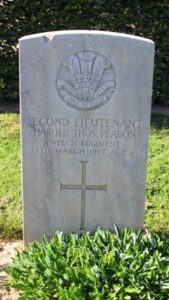
Dan Phillips, Corporal, 40214, Royal Welsh Fusiliers. Dan was the son of William and Anne Phillips, of Blaenhiraeth, Henllan, Whitland. He was educated at Whitland Grammar School and was a student at the South Wales Training College at Carmarthen when he enlisted there into the army and was posted to France in 1916, joining the 10th Battalion, Royal Welsh Fusiliers, which was attached to 76 Brigade, 3rd Division, and had suffered heavy casualties during its first major action, at the St. Eloi craters, south of Ypres. The division moved south to the Somme, entraining at St. Omer on 1 July 1916 and reached Carnoy on 13 July, while the Welsh Division was moving away from the same area following its assault on Mametz Wood. By now Dan had been promoted to Acting Corporal. The 3rd Division moved into the line on 14 July in order to take part in the assault on Delville Wood, Longueval and Bazentin le Grand. The 10th RWF remained in reserve for the initial attack, but would soon be thrown into the fray as on 20 July was given the task of entering Delville Wood and clearing along Princes Street. The battalion suffered heavily before reaching the wood, where South African scouts met them and the 10th RWF advanced into a fierce fight which earned the battalion two Victoria Crosses. The 10th RWF, relieved from Breslau Trench on 25 July, did not go back into action until moving back into the front, reaching Talus Wood on 14 August, and its officers reconnoitred the Casement, Dublin and Chimpanzee trenches in front near Guillemont before taking them over on 15 August and spent much of the day consolidating them, suffering three men killed and four wounded. On the following day the battalion attacked Lonely Trench, but were beaten back, suffering five officers and 116 men killed between 16 and 19 August. Dan was posted as missing during the initial attack on Lonely Trench on 16 August 1916. He was later found to have been killed in action that day. He was 25 years old and is commemorated on the Thiepval Memorial, France. Dan is commemorated in the Memorial Hall at Whitland, at Whitland Gramamr School and at Henllan Amgoed.
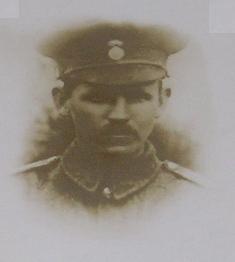
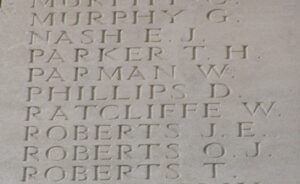
Gwynedd William Llewelyn Pritchard, MC, Captain, Manchester Regiment. Gwynedd was the son of William Jones Pritchard and Emily Caroline Pritchard, of 1, St. Clement’s Avenue, Bloxwich, Walsall, Staffs. Following his education at Carmarthen College he remained in the town, living at 2, Water Street, Carmarthen. He originally enlisted at Carmarthen into the Welsh Field Company, Royal Engineers, but gained a commission into the 20th Battalion, Manchester Regiment, which had been in France since November 1915 with the 7th Division. The division moved to Italy in November 1917 and for a while Gwynedd was Town Major of Riese. Whilst on leave in August 1918 he married Gertrude Muriel Davies, of Carmarthen, at Walsall, and re-joined his battalion back in Italy. On 13 September 1918 his battalion joined 7 Brigade, 25th Division in France, and took part in the final offensive. Gwynedd was sadly killed in action soon after arriving back in France, during the Battle of the Selle on 23 October 1918. He was 25 years old, and is buried at Pommereuil British Cemetery, France. Gwynedd was the holder of the Military Cross. The award was listed in the London Gazette of 7 March 1919, and read; ‘On 8th October, 1918, during the advance on Sonia Farm, he displayed great gallantry and initiative in handling his company. Troops on the right having lost direction and a gap resulting, he made good first Bronx Farm and later Foal Copse, the latter being strongly held by machine-guns, which would undoubtedly have held up the main advance on the left when it came to be proceeded with. He personally led his company in the attack on Foal Copse.’
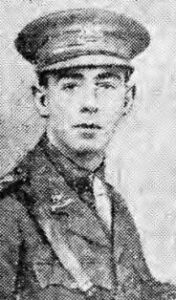
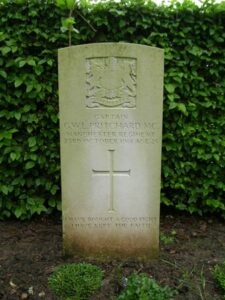
Rees Thomas Prytherch, Private, 70532, King’s Liverpool Regiment. Rees was born in 1883, the son of William Prytherch and Elizabeth Prytherch (nee Williams), of Lower Genffordd Farm, Talgarth. He was educated at Brecon County School and at Carmarthen Training College before training as a minister, graduating BA with Honours from the University of Wales, Cardiff, in 1903. He became a well-respected Methodist Minister at Swansea, then Hay, and was often to be seen taking services in the Market Square in Talgarth. He tried to enlist into the infantry soon after the outbreak of war but was rejected several times as unfit, due to a deformity in his leg which he had suffered from as a result of an accident while a young boy, but in 1917 he was finally accepted into the Labour Corps, joining the 13th Labour Company, King’s Liverpool Regiment. He became ill and died of meningitis in hospital at St. Omer on 23 March 1917, just ten days after arriving on the Western Front. The 34-year-old is buried in Longuenesse (St Omer) Souvenir Cemetery, France. Rhys is commemorated on war memorials at Swansea, Hay and at Trinity College, Carmarthen.
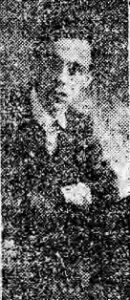
John Hywel Richards, MC, Lieutenant, South Wales Borderers. John was the son of the Reverend Benjamin Frederick Richards and Mrs Annie Richards, of Francis Villa, Carmarthen. He studied as a Calvinistic Methodist Student at Aberystwyth and Carmarthen prior to the war, and in 1915 enlisted as a Private with the Army Veterinary Corps. He was commissioned into the 6th Battalion, South Wales Borderers in 1916, which was the Pioneer Battalion to the 25th Division. The Division fought throughout the Battle of the Somme, and then moved to Ploegsteert, where they held the line for the months leading up the Battle of Messines in June 1917. After fighting at Messines, the Division moved north, and fought at Pilckem, before moving south again, where they took up positions around Bullecourt in reserve. They moved north to Flanders on the night of 30 March 1918, where they took up positions at Ploegsteert again, where they received reinforcements, and rebuilt. John was awarded the Military Cross for Westhoek Ridge, during Third Ypres. The award was listed in the London Gazette of 8 January 1918, and read; ‘For conspicuous gallantry and devotion to duty when in charge of a convoy. He went forward during a hostile counter-attack and reconnoitred the ground to find the best route for the animals through both the barrage and shell-holes, under heavy shell fire, through which he then led them without hesitation, sustaining only a few casualties. He successfully delivered the stores and ammunition which were urgently required. He has on several occasions shown remarkable initiative and great gallantry during similar journeys.’ John was mortally wounded during the German Spring Offensive on the Lys on 11 April, and died of wounds on 19 April 1918, aged 27. He is buried at Aire Communal Cemetery, France.
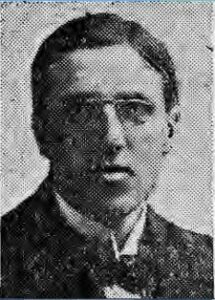
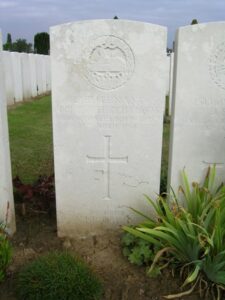
Percy Charles Shean, Rifleman, 533950, London Regiment. Percy was the son of Walter Henry and Elizabeth Shean, of 24 Valletta Grove, Plaistow, West Ham. He was educated at Carmarthen Training College just before the outbreak of war, and enlisted into the 2nd/15th Battalion, London Regiment (Prince of Wales’ Own Civil Service Rifles). The battalion was attached to 179 Brigade, 60th (2/2nd London) Division, and had moved to Salonika from France in November 1916, before seeing service in Egypt. Percy must have been attached to another battalion, most likely the 1st/15th Battalion, London Regiment, which was attached to 140 Brigade, 47th (2nd London) Division, as he remained in France and was wounded towards the end of the war. He died of his wounds at the 2nd Canadian Stationary Hospital, Wimille on 24 October 1918, aged 28, and is buried in Terlincthun British Cemetery, Wimille, France.
Thomas Granville Stephens, Private, 4271, Welsh Regiment. Thomas was the son of John and Elizabeth Anne Stephens, of Brynmor, Llwynhendy. He was a student at the South Wales Training College when he enlisted at Carmarthen into the 1/4th Battalion, Welsh Regiment, which was the local Territorial Battalion, attached to 159 Brigade, 53rd (Welsh) Division. The Division landed at Cape Helles, Gallipoli, on 9 August 1915, and was immediately thrown into action, spending the next few days in isolated pockets, fighting against a Turkish counter-attack during the Battle of Sari Bair, and then at the Attack on Scimitar Hill. Thomas was posted as missing, believed killed in action, during the Battle of Sari Bair, on 11 August 1915. He was just 21 years old, and is commemorated on the Helles Memorial, Gallipoli.
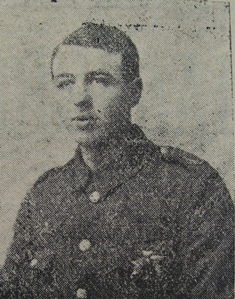

William Bowen Stephens, Private, 282274, Lancashire Fusiliers. William was born on 26 February 1896, the son of Catherine Stephens, of the Park-y-Lan Inn, Llanddewi Velfrey. Catherine married William Thomas in 1900, and the family continued to live at Park-y-Lan. William was educated at Carmarthen Training College before enlisting at Cardiff into the army, and was posted to the 2/7th Battalion, Lancashire Fusiliers, which formed part of 197 Brigade, 66th Division. The Battalion landed at Havre on 28 February 1917, moving to the Nursery Sector around Givenchy. The battalion took up the front-line trenches at Beuvry for the first time on 15 March 1917, starting a period of trench initiation alongside the experienced 5th Division, and two days later were the recipients of an intense artillery barrage which was followed by a trench raid by the Germans. Over the following weeks the battalion took turns both in the front line and in reserve and support, rotating with the other divisional troops. On 13 April 1917 the battalion moved into the front-line trenches on the Givenchy right sub-sector, for a five-day spell. On the afternoon of 18 April 1917, William was selected to be among a party of 2 officers and 24 other ranks who had been tasked with a trench raid on the German lines opposite, in order to gain identification. The party made its way across No Man’s Land, but found the Germans to be fully alert, and came under heavy fire, forcing them to retire. William was among the reported casualty list of four men wounded and five missing, but his body was never found. He was 21 years old and is commemorated on the Loos Memorial, France. The photo of William is courtesy of Narberth Museum.
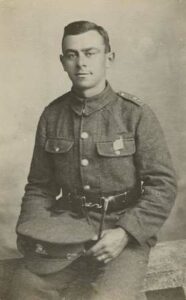
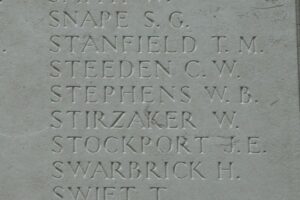
Archibald Steven, Second Lieutenant, Worcestershire Regiment. Archibald was the son of James and Sarah Steven, of 226, The Portway, West Ham, London. He was educated at Carmarthen Training College prior to taking up a teaching position with London County Council, but gave up his position to enlist into the 18th (Public Schools) Battalion, Royal Fusiliers and on 14 November 1915 landed in France. Archibald was commissioned into the 10th Battalion, Worcestershire Regiment on 1 June 1916, and was attached to the 8th Battalion, Gloucester Regiment, which was on the Somme. On 12 October 1916 the 8th Gloucesters were stationed in the Bois de Warnimont, training and practising an attack with their brigade from Louvencourt towards Authie. The brigade marched to billets in Warloy on the 17th, and on 22 October 1916 marched out via bivouacks on the Albert to Bouzincourt Road to positions north of Ovillers and east of Authille Wood, on the Thiepval Ridge. On the afternoon of the 24th the battalion relieved the 8th North Staffs in the front-line east of Thiepval, with Battalion HQ being set up in Stuff Redoubt. During the following morning the front line was swept by a heavy artillery bombardment, and the Gloucester’s suffered the death of one officer and another wounded. The dead man was Archibald, who was 26 years old. He has no known grave and is commemorated on the Thiepval Memorial, France.
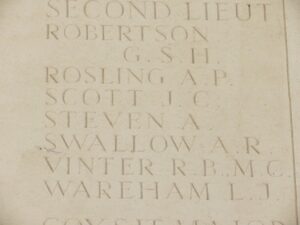
Leonard Frank Taylor, Second Lieutenant, South Staffordshire Regiment. Leonard was born on 8 October 1890, the son of Isaiah and Mary Taylor, of Spring Vale Farm, Birmingham Road, Walsall. He was educated at Carmarthen College where he became well known as an excellent cricketer. When he returned to Walsall to take up a teaching position he played for the Walsall cricket team and for Staffordshire, and had qualified to play for Warwickshire prior to the war. He enlisted into the Artists Rifles O.T.C. following the outbreak of war and on 11 July 1916 was commissioned into the South Staffordshire Regiment. He was posted to the 1st/5th Battalion, South Staffordshire Regiment, which was attached to 137 Brigade, 46th (North Midland) Division. He joined the battalion on 14 August 1916 on the Somme, where the division had suffered heavy casualties as a result of launching a diversionary attack at Gommecourt on 1 July. They rested for several months at Arras, and at the end of 1916 took part in Operations on the Ancre. Leonard was killed leading his men against German positions at Bucquoy on 14 March 1917. He was 26 years old and is buried in Foncquevillers Military Cemetery, France.
Brychan Thomas, Private, 7648, London Regiment. Brychan was the son of Thomas and Mary Thomas, of Devynock, Brecon. After receiving his education at Carmarthen Training College, he became a schoolmaster at Caegarw School, Mountain Ash, and also became the Conductor of the Aberdare Parochial Choral Society. Brychan enlisted at Aberdare into the 15th Battalion, London Regiment, but was then posted to the 2/20th Battalion, London Regiment (Blackheath and Woolwich), which was attached to 180 Brigade, 60th (2/2nd London) Division. The battalion embarked at Southampton on 26 June 1916 for service in France, and began training alongside the 51st (Highland) Division. After a brief period of trench initiation, the battalion became responsible for its own sector at the Quarries near Neuville-St.-Vaast from 12 July 1916, and began aggressive patrolling in the sector beneath Vimy Ridge. From this date until the division left this sector at the end of October 1916 the battalion had suffered three officers and 48 other ranks killed or died of wounds, and five officers and 187 men wounded. Among those killed was Brychan, who was killed in action on 16 October 1916, aged 32. He is buried in Ecoivres Military Cemetery, Mont-St. Eloi, France. His brother, Lieutenant Thomas Thomas, a teacher at Aberdare, served with the Royal Garrison Artillery, and was awarded the Italian Al Valore Militaire, which was presented to him by the Duke of Aosta.
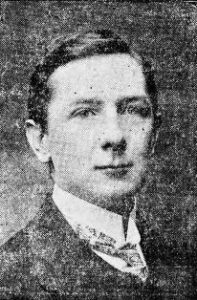
Cuthbert Gordon Thomas, Private, 229317, South Wales Borderers. Cuthbert was the son of Arthur John and Mary Maude Thomas, of Bank House, Llangorse, Brecon. He was educated at Brecon Grammar School and at Carmarthen Training College prior to becoming a schoolmaster at Felindre school, leaving there to take a post in the Upper Rhymney School, and enlisted at Merthyr Tydfil on 24 January 1916. He was posted to the 3/1st Battalion, Monmouthshire Regiment, and was mobilised on 27 February 1917, embarking for France where he was posted to the 11th Battalion, South Wales Borderers, which was attached to 115 Brigade, 38th (Welsh) Division. He joined the battalion in its positions on the canal bank at Boesinghe, from which they launched their assault on the Pilckem Ridge, on the opening day of the Third Battle of Ypres on 31 July 1917. Cuthbert was killed in action during his battalions assault that day. He was 26 years old and is buried in Duhallow A.D.S. Cemetery, Belgium.
Ivor James Thomas, Private, 4019, Welsh Regiment. Ivor was the son of Thomas and Sarah Thomas, of 140, Wood Road, Pontypridd. He was educated at Pontypridd Intermediate School before attending Carmarthen Training College and had received an appointment with the Rhondda Education Committee prior to enlisting into the College Platoon of the 1/4th Battalion, Welsh Regiment. The battalion embarked for the Mediterranean with 159 Brigade, 53rd (Welsh) Division and landed at Cape Helles, Gallipoli, on 9 August 1915. The division was ordered to advance but the separate units became isolated and were caught up in heavy fighting over the coming days, suffering terrible casualties. Ivor was killed in action during the attack on Scimitar Hill on 10 August 1915, aged 23. He has no known grave and is commemorated on the Helles Memorial, Gallipoli.
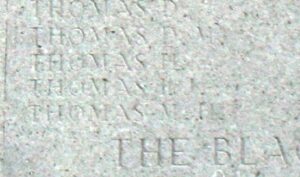
William Thomas, Private, 48948, Royal Army Medical Corps. William was born at Cilgerran, the son of David and Margaret Thomas. He spent four years as a pupil teacher at Cilgerran school before going on to Cardigan Intermediate School and then spent a period at Carmarthen Training College. After qualifying as a teacher, he was appointed headmaster at Henry’s Moat School in Pembrokeshire. Having only been there for a period of eighteen months he was promoted to headmaster of Llanddewi Velfry School, where he spent five years before enlisting at the end of 1915. He was posted to F Company, Royal Army Medical Corps, which was a training company based at Redan Hill, Aldershot. He married Daisy Victoria Thomas, a fellow teacher, from Narberth on 1 January 1916. Not much is known of William’s time at war, but he returned home to Narberth on 11 March 1916 suffering from ill health, and sadly died at home of sickness on 22 March 1916, aged 27. William is buried at Narberth Cemetery.
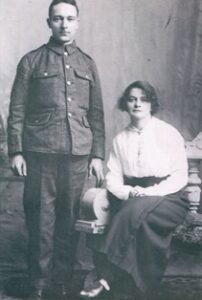
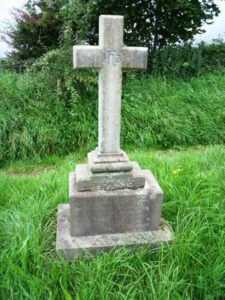
Edward Bertram Walters, Private, 4275, Welsh Regiment. Edward was the son of Adam and Margaret Walters, of Pengam, Cardiff. He was a student at the South Wales Training College, Carmarthen at the outbreak of war, and enlisted there into the 1/4th Battalion, Welsh Regiment, which was the local Territorial Battalion, attached to 159 Brigade, 53rd (Welsh) Division. The Division landed at Cape Helles, Gallipoli, on 9 August 1915, and was immediately thrown into action, spending the next few days in isolated pockets, fighting against a Turkish counter-attack during the Battle of Sari Bair, and then at the Attack on Scimitar Hill. Edward was killed here on 10 August 1915. He was 23 years old, and is buried at Green Hill Cemetery, Gallipoli.
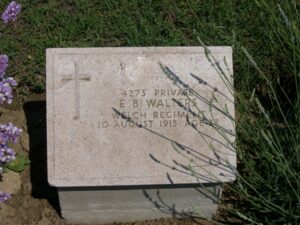
James Wightman, DSO, MC, Major, East Surrey Regiment. James was the son of James and Sarah Wightman, of Harras Moor, Whitehaven, Cumberland. He was a student at Carmarthen College when he met his future wife, Eleanor Gertrude Morris, the daughter of William and Hetty Morris, of 2, Tabernacle Terrace, Carmarthen, and they married at St. Peters Church, Carmarthen on 16 August 1915. James was a promising footballer before the war, and was Captain of Barry Town FC during their final pre-war season of 1913-1914. At the outbreak of war, James was a teacher at Troedyrhiw, and enlisted as a Private. He gained rapid promotion, and by 1915 was a Captain with the 8th Battalion, East Surrey Regiment. The battalion was attached to 55 Brigade, 18th (Eastern) Division, and landed in France on 25 May 1915. The Division saw its first major action during the Battle of the Somme. On the first day of the battle, 1 July 1916, the 8th East Surreys attacked at Montauban, famously by kicking two footballs out into no man’s land. On 30 September the battalion attacked the Schwaben Redoubt, and William gained the award of the Military Cross for his bravery there; ‘For conspicuous gallantry in action. He led a bombing party with great courage and determination, and repulsed the enemy. He acted as leading thrower, and threw bombs continuously for two hours. He has previously done fine work to advance the attack.’ In March 1917 the division followed the German Retreat to the Hindenburg Line, and in May took part in the Third Battle of the Scarpe, which was part of the Arras Offensive. July 1917 saw the Division at Ypres, where they took part in the Battle of Pilckem, where they helped capture Westhoek, and then they fought at Langemarck, and at Passchendaele. The Division then moved to the St. Quentin sector over the winter, where they were hit by the German Spring Offensive of 21 March 1918, and took part in heavy fighting, which led to the award of the Distinguished Service Order to James. James sadly became injured by a hand grenade around this time, and died on 9 April 1918. He was 25 years old, and is buried at Picquigny British Cemetery, France.
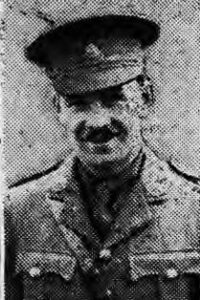
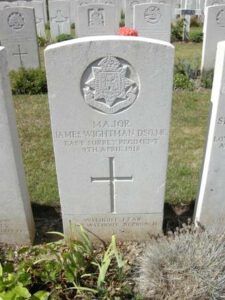
Clifford Wilkes, Captain, South Staffordshire Regiment. Clifford was the son of Samuel and Edna Wilkes, of 270, Walsall Road, Falsall Heath, Wednesbury. He graduated from Carmarthen Training College before gaining a position with the Walsall Education Committee prior to the war. He married Nellie Horton in the summer of 1916, and the couple made their home at Ivydene, Pinfold Street, Darlaston, Staffs. Clifford had served with the 4th Welsh whilst living in Carmarthen, and after the outbreak of war enlisted into the 2nd Battalion, South Staffordshire Regiment, which was attached to 6 Brigade, 2nd Division. He served with the battalion in France from 3 March 1915, and rapidly became promoted sergeant, before gaining a commission that year. He was soon promoted to Captain and was attached to the 6th Trench Mortar Battery, in the same brigade. In 1915 the Division saw action at Bellewaarde and Hooge, and took part in the Second attack on Bellewaarde, and in 1916 fought at the Actions of the Bluff, and at the St Eloi Craters. They were then moved south to the Somme, and fought there at the Battle of Albert, and the Battle of Bazentin, where they captured Longueval. They then took part in the Battle of Delville Wood, and the Battle of the Ancre, before settling into another bleak winter in France. In May 1917 the Division were at Arras, and fought at the First and Second Battles of the Scarpe, and at the Battle of Arleux and the Third Battle of the Scarpe, where they captured Roeux. Clifford was killed in action during the attack north of Monchy-le-Preux on 28 April 1917. He was 25 years old and is commemorated on the Arras Memorial, France, as he has no known grave.
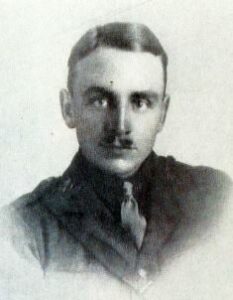
John Lloyd Williams, Private, 2841, King’s Liverpool Regiment. John was the son of George and Jane Williams, of 2, Castle Square, Haverfordwest. He trained as a school teacher at Carmarthen, and worked at Liverpool Sailors Orphanage prior to the war. John enlisted there into the 6th Battalion, Kings Liverpool Regiment on 9 November 1914. The battalion landed in France on 25 February 1915, and joined 15 Brigade, 5th Division at Bailleul. On 18 November 1915 the Battalion moved to Third Army Troops, and on 26 January 1916 moved to 165 Brigade, 55th (West Lancashire) Division. The Division relieved the French 88th Division south of Arras, where it took part in many raids and minor operations. Relieved by the 11th (Northern) Division on 25 July, the Division moved south and took up a place in the front line opposite the village of Guillemont. Here they fought at the Battle of Guillemont and the Battle of Ginchy. John was wounded when the battalion was in positions at Maltz Horn Farm, from which a series of assaults were launched against the village of Guillemont, and died on 9 August 1916, aged 27. He is buried in Guillemont Road Cemetery, Guillemont, France.
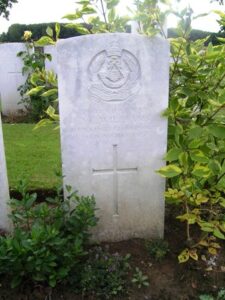
Herbert Sydney Zoller, Rifleman, 653079, London Regiment. Herbert was the son of Hester Zoller of Wandsworth. He married Flora Constance G. Thomas, of Castle Hill Villa, at Carmarthen in 1907, and the couple later resided at 34, Verdant Lane, Catford, London, where Herbert had taken up a teaching post. Herbert enlisted at Camberwell into the London Regiment, and was posted to the 1/21st Battalion (First Surrey Rifles), London Regiment. On 16 March 1915 the battalion landed at Le Havre, where it became attached to 142 Brigade, 47th (2nd London) Division. The Division fought at the Battle of Aubers, and the Battle of Festubert during May 1915 and in September fought at the Battle of Loos, and subsequent Action of Hohenzollern Redoubt. They were north of Arras when the Germans attacked Vimy Ridge, and then moved south to the Somme, where they fought at the Battle of Flers-Courcelette, and then at the Battle of Le Transloy, where the Division captured Eaucourt l’Abbe, and took part in Attacks on the Butte de Warlencourt. Early in 1917 the Division moved north to Belgium, and took part in the Battle of Messines. Herbert was killed here during the capture of White Chateau on 7 June 1917. He was 36 years old, and is commemorated on the Ypres (Menin Gate) Memorial, Belgium. A bundle of his letters home was sold at Strides Auction House in July 2010.
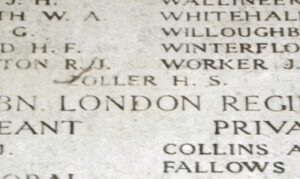
World War 2, 1939-1945
William Llewellyn Wynn Jones, Flying Officer, 135670, Royal Air Force Volunteer Reserve. William was born on 5 February 1909, the son of John Henry Jones and Martha Lilian Jones, of The Globe Inn, Blaina. He studied at Trinity College, Carmarthen prior to becoming a schoolteacher, and upon his return to Blaina married Florence Eileen Chaffey. The couple then moved to 90, Rectory Road, Thurrock, where William had gained a position as Deputy Schoolmaster. William enlisted into the Royal Air Force Volunteer Reserve soon after the outbreak of war and after qualifying as a Navigator was posted to 514 Squadron, Royal Air Force, which flew the Avro Lancaster II, based at RAF Waterbeach. On 1 May 1944, William took off from Waterbeach aboard an Avro Lancaster II, Serial LL732, which joined a large bomber group despatched to hit railway installations in Chambly, the main railway depot and stores for the northern French railway network. The raid was extremely successful, but during the return leg on the following morning, 2 May 1944, William’s Lancaster was intercepted and shot down by a German night-fighter, crashing near Chaumont-en-Vexin, France, with the loss of all seven crewmen. William was 35 years old when he was killed that day and was buried besides his fellow crewmen in St. Sever Cemetery Extension, Rouen, France. His widow, Florence, went to live with her parents at Bourneville, Birmingham after William’s death. She never remarried and died in 2004.
————————————————————————————————————————————————————————————————————————-
Carmarthen Training College Contribution to the War Effort
On 23 October 1914 an anonymous letter was published in local press, condemning what the writer saw as apathy towards the war by members of the college.
In response, the Principal of Carmarthen College, Reverend Albert William Parry, wrote an open letter to The Welshman newspaper, which was published on 30 October 1914:
Sir.
My attention has been drawn to a letter which appeared in the correspondence column of your issue of October 23rd. In reply to the question addressed to myself contained therein, I wish to submit the following statement:
- Of the students who were members of the Carmarthen Training College during the session 1913-1914, 90 percent of those eligible were members of the Territorial Force and are now mobilised at Fort Scoveston. I am proud to be able to add that with very few exceptions these young men have offered themselves for foreign service.
- Four out of seven members of the College staff hold commissions in H.M. Army. Lieut. H.M. Green (College Secretary) is the Officer Commanding E Company, 4th Battalion, Welsh Regiment, at Fort Scoveston; Lieutenant W.L. Dudley (Lecturer in English) serves in the same battalion; Lieutenant C.K. Cotton (Lecturer in Education) is attached to the 3rd Battalion, Cheshire Regiment and is stationed at Birkenhead. I, personally, hold a commission as Chaplain to the 4th Battalion, Welsh Regiment and visit my battalion as frequently as I possibly can.
- A certain number of students now resident at the College are members of St. Mark’s College, Chelsea and are now completing their period of training here owing to the fact that their college is being utilised as a military hospital. The majority of these young men were members of the 10th Middlesex Regiment and volunteered for foreign service, but were rejected at the medical examination that took place prior to the departure of the regiment abroad.
- In the case of those students who have entered the College this year, the Board of Education has issued official instructions to the effect that they are not to be allowed to enlist at present. They are, however, being carefully trained and will be able to give a good account of themselves when occasion arises.
- A considerable amount of the ex-students of the College have also offered themselves for military service. A list of these is being prepared and will be issued as soon as complete.
I believe that I can assert with every confidence that no other educational institute in Wales has contributed so great a proportion of its staff and students for military service at the present juncture as the Carmarthen Training College.
Yours faithfully,
A.W. PARRY, Principal.
In continuation, the December 1914 issue of the Carmarthen College Magazine published a lengthy article chronicling the efforts of the College towards the war effort:
————————————————————————————————————————————————————————————————————————-
THE COLLEGE AND THE WAR.
The College Magazine is intended to serve as a permanent record of the life of the College it is most fitting that the present issue should contain some account of the part played by this College at so grave a crisis in our national history.
Of recent years the College Company, (Fourth Battalion Welsh Regiment), has become of increasing importance in College life. With scarcely an exception, all Students who were physically fit offered themselves as recruits on their admission here, and when term ended in July last, and the Students went down, they did so knowing that after a very brief period they would meet again when the College Terriers should reassemble at camp.
This year Portmadoc was selected for our annual training. Scarcely, however, had we arrived there we learnt that mobilisation orders had been received. A hurried return to Carmarthen then became necessary, and the College Examination Hall was put to a new use. Previously we had regarded it as a place of terror, in which we struggled desperately with various examination papers; now it remains in our memory as a place in which we spent some hours of most acceptable repose.
We left Carmarthen on August 5th and went by train as far as Milford, from whence we were called upon to march to Dale—some thirteen miles away. The memories of that march still haunt some of us. More than one man marched whilst sleeping. Never did any welcome their destination more than we welcomed Dale. As soon as the Company was dismissed the great majority of us simply lay down on the ground and fell fast asleep.
Our life at Dale was of a busy and exacting character. After a while we were divided into two sections, one being stationed at West Blockhouse, the other at St. Anne’s. In each case the duty was similar, viz., that of being on the alert day and night against any possible invasion of our country in that part allotted to our charge.
From Dale the whole battalion was moved to Fort Scoveston in order that training of a different character might be undertaken by us. Physical training became of great importance here, and the College Students were in great demand as instructors to the various Companies of the Battalion.
At Scoveston, too, we had the unpleasant experience of being inoculated against typhoid and various evils which the medical authorities concluded it advisable to arm us against.
On Nov. 5th the College Company was ordered to Swansea Docks. These docks had previously been protected by the 6th Battalion, but as they had been sent away to France it fell to our lot to take their place at Swansea. Our stay in this quarter was, however, of very brief duration, as on Nov. 15th we returned once again to Fort Scoveston. Here the whole Battalion assembled to prepare itself for immediate departure for foreign service. Our actual destination is unknown. So far as we can gather we believe that India is to be shortly visited by us. Whether that is so or not, each ‘Carmarthenite’ is equally ready to obey the orders received, and to play his part, to the best of his ability, in that region of the world to which his country sends him.
Of the Staff of the College, four hold commissions. The Principal is Chaplain (ranking as Captain), and has visited us nearly every Sunday, holding services wherever the College Company was located. Lieut. H. M Green has commanded the College Company since mobilisation as Captain. J. F. de Rees is acting as Adjutant to the Battalion. Lieut. W. L. Dudley is also with us, while Lieut. C. K. Cotton, who enlisted after the declaration of war, has been attached to the 3rd Battalion Cheshire Regt.
————————————————————————————————————————————————————————————————————————-
List of Members of the Carmarthen Training College who are attached to the Fourth Battalion Welsh Regiment.
Rev. Principal Parry {Chaplain).
H. M. Green, Esq., (Lieut.) W. L. Dudley, Esq. (Lieut)
W. G. Brunker, C. Chadwick, S. Clayton, A. I. Davies, Brinley Davies, Norman Davies, T. C. Davies, H. J. Dennis, F. G. England, H. G. Gardner, R. Hopkins, H. T. Horsfall, W. M. Jones, Edward Jones, G. W. Lambert, G. M. Loyn, J. LI. Lewis, C. H. Mould, C. R. Pritchard, W. Roblin, P. J. R. Sanders, F. H. Smith, T. E. Smith, L. A. Swash, A. J. Thomas, F. Peadon, T. J. Thomas, J. Thomas, J. G. Tossell, J. J. Chaplin, W. W. Dobson, A. D. Evans, D. H. Griffiths, W. G. Davies, W. R. Davies, W. Evans, Heslop Harrison, E. H. Heath, L. N. James, David Jones, H. E. Lewis, O. A. Morgan, A. Lloyd, W. P. Phillips, H. M. Rees, J. S. S. Rowlands, T. G. Stephens, W. M. B. Thomas, E. B. Walters, H. C. Whiteside, T. J. Evans, Gordon Williams, John Price, E. C. Richards, W. Roderick, I. W. Thomas, J. Lot Thorn, G. H. Walton, A. J. Hughes, J. H. Jones.
————————————————————————————————————————————————————————————————————————-
WITH THE COLOURS.
Another newspaper article published just afterwards noted: The following Students have recently (December 1914) left the College to undertake military service:—
W. E. Boot, Sergt.-Major, South Staffs
W. H. Boot, Sergt., South Staffs
H. Cross, Brecknocks
S. R. Davies, R.F. (Public Schools)
T. J. Evans, Brecknocks.
F. P. George, Lieut., South Staffs
E. R. Griffiths, R.A.M.C.
J. Griffiths, R.A.M.C.
T. R. Howells, Sergt.-Instructor, R.W.F.
J. T. Hughes, R.A.M.C.
Ben James, Corpl., R.W.F.
O. James, R.A.M.C.
S. James, R.W.F.
D. LI. Jenkins, R.A.M.C.
D. Jones, R.W.F.
E. D. Jones, R.W.F.
T. I. Jones, 7th Welsh (Cyclists)
W. D. Jones, R.A.M.C.
W. J. Jones, 7th Welsh (Cyclists)
F. G. Leaker, R.A.M.C.
G. H. Lewis, R.F. (Public Schools)
J. J. Leyshon, R.N.R.
T. J. Morgan, R.A.M.C.
H. G. Morris, R.W.F.
J. LI. Morris, R.W.F.
W. G. Nicholas, R.W.F.
T. R. Owen, R.A.M.C.
E. C. Parry, Brecknocks
W. H. Parry, R.A.M.C.
A. Phillips, CorpL, R.W.F.
H. E. Reed, R.E.
I. G. Reed, R.A.M.C.
W. J. Richards, R.F. (Public Schools)
W. W. Richards, R.F. (Public Schools)
T. O. Roberts, R.W.F.
D. A. Stark, Gordon Highlanders
D. W. Thomas, R.A.M.C.
Eb. Thomas, R.A.M.C.
Evan Thomas, R.A.M.C.
T. Thomas, R.A.M.C.
T. A. Thomas, Sergt., 5th Welsh
T. G. Thomas, R.F. (Public Schools)
T. Watkin, R.F. (Public Schools)
B. J. Williams, Sergt., R.F. (Public Schools)
C. I. Williams, R.F. (Public Schools)
W. W. A. Williams, 5th Welsh
S. G. Voyle, Lieut., Lancasters
————————————————————————————————————————————————————————————————————————-
The Cambria Daily Leader of 12 February 1916 published the following table of members of the Carmarthen Training College who had so far taken up arms:
COLLEGIANS IN THE COLOURS.
The following figures relating to the members of the Carmarthen Training College who were on active service prior to the passing of the Compulsion Act are of interest:
Members of the College Staff 7
Present and Past, Students 243
Number holding commissions 55
Non-commissioned officers 46
Killed 2
Missing 6
Wounded 10
The December 1919 Edition of The Carmarthen (College Magazine) published a detailed list of all the then present students who served during the war and survived:
————————————————————————————————————————————————————————————————————————-
CARMARTHEN STUDENTS AND THE WAR.
BELOW we print a short account of the part taken in the War by those of our present Students who had an opportunity of serving. It was thought that readers of The Carmarthen would like to have this permanent record.
Andrews, R. H., enlisted in December, 1915, and served as a lieutenant in France with the 15th Bn. The Welsh Regt.
Ashton, W. G., joined the 2nd Bn. Lincolnshire Regt. in April, 1917, and served with that battalion in France: was captured near Rheims in May, 1918.
Barnsley, T. J, joined the R.N.V.R. on June 3rd, 1918, and served as a telegraphist on H.M. Trawler Chrysea on minesweeping service.
Bayton, D. J, enlisted in March, 1917, was stationed for a time in Ireland, and afterwards served in France and Germany with the Cheshire Regt. and R.E.’s.
Bevan, E. W., joined R.N. at Devonport in March, 1915, and served as a third writer under various commands afloat and ashore.
Bowen, I., joined the South Wales Borderers in Feb., 1918, and afterwards served in the R.A.F. on patrol duty on S. and E. coast.
Bowen, W. E., served with the King’s Liverpool Regt. at Prees Heath in 1918, and was afterwards employed on The City of Poona, engaged in transporting prisoners of war.
Chapman, E. J., enlisted in the 3/1st Herts. Regt. in Feb., 1916. After being discharged he re-enlisted and served in the R.F.A. and the Rifle Brigade.
Chinn, H., served in the Norfolk Regt. and the Royal Fusiliers, and was appointed sergt. instructor at Warley Garrison School.
Cole, J., joined R.N.V.R. in January, 1918, served on an armed trawler minesweeping from Milford Haven, and afterwards as a telegraphist on H.M.S. Queen on Taranto Barrage.
Cross, T., joined Brecknock Bn. S.W.B. in Dec, 1915. After acting as sergt. instructor with 53 (Y.S.) Batt. S.W.B. at Kinmel Park, he served in France with the 1st Bn. Monmouthshire Regt.
Crowe, W. A. Driver, Tank Corps. (Pembroke Dock)
Davies, E., served as a wireless observer in the R.A.F. Davies, T. J., joined R.W. Fusiliers in November, 1915, served in France with the 10th R.W. Fusiliers in 1916 and 1917, was captured on the first day of the German March offensive in 1918, and worked in German coal mines.
Davies, S. R., joined the Royal Fusiliers in Nov., 1915, was commissioned in August, 1917, and served on the Western Front.
Devonald, D., joined the 3rd Bn. S.W.B. in Sept., 1916. Served in India, and with 4th S.W.B. in Mesopotamia from April, 1917, till the Turkish Armistice in November, 1918.
Dobson, W. W., was mobilised with the 4th Welsh on August 4th, 1914. After training at Dale, Fort Scoveston, Royston, and Bedford, he saw service in Gallipoli, Egypt, and Palestine. He gained a commission in the 4tw Welsh.
Dowdall, F. O., enlisted in Sept., 1915, and after training at Winchester, Bedford, and the East Coast served as a signaller in France with the 18th Division.
Ebsworth, J. E., joined the R.F.C. in Jan., 1918, training at Hastings, Farnborough, and Blandford. After being discharged he rejoined in the M.G.C.
Edwards, D., joined the Grenadier Guards at Christmas, 1914, was transferred to the Welsh Guards in March, 1915, and served with the 1st Batt. for nearly three years in France.
Edwards, E. J., joined the R.N.V.R. in Feb., 1917, and served as a telegraphist on a minesweeper along East Coast of England and at Sierra Leone, W. Africa.
Evans, D. W., served as a signalman in the R.N.V.R. from April, 1917, to Jan., 1919.
Evans, J. J., joined the K.O.R. Lanes, in December, 1917, and afterwards served with R.W. Fusiliers and the Welsh Guards.
Evans, J. P., served as a wireless observer in the R.A.F. on the East Coast patrol.
Evans, J. R., joined the R.N.A.S. in Oct., 1917, and served as a 1st aircraftsman on North Sea patrols. He afterwards qualified as a telephone operator.
Evans, T. J., enlisted in Feb., 1917, and served in France with the 2nd Bn. R.W.F., and afterwards with the 4th Batt. R.W.F. He was wounded on Passchendaele Front in November, 1917.
Evans, W., was mobilised with the 4th Welsh on August 4th, 1914, and served with that battalion in Gallipoli, Egypt, and Palestine. He was gazetted 2nd lieutenant in 1917, and served in France with the 16th and 9th Welsh Regt.
Evans, Wm., joined the R.N. in Oct., 1916, and served as a victg. assistant on H.M.S. Bicester from August, 1917, to June, 1919.
Francis, C, enlisted in 3rd Cav. Res. Regt. on Sept. 3rd, 1914, was transferred to the Buffs (E. Kent Regt.) in June, 1915, and served with the 2nd Bn. in France, Egypt, Macedonia, and Turkey.
Games, A. W., enlisted in May, 1917, was stationed for a time in Ireland, and afterwards served in France with the 2/8 Bn. The Worcestershire Regt.
Goodwin, W., enlisted in July, 1918, and served with the 4th R.W. Fusiliers.
Gray, R., enlisted in May, 1917, and served in France from Dec, 1917, till the Armistice with the 12th Bn. S.W. Borderers and 14th Bn. The Worcestershire Regt.
Hamm, S., joined the Welsh Guards in April, 1915, and served with them in France. He was wounded Sept., 1915, and January, 1916, and was discharged through wounds in 1917.
Hicks, P., enlisted in 2/6 Bn. The Gloucestershire Regt. in October, 1915, and served with that regiment in France from May, 1916, to August, 1919- At the time of the Armistice he was in training with No. 2 Cadet Bn., Salisbury Plain.
Hood, P. J., enlisted in the R.F.A. in Sept., 1914, and served in France for two periods. He was wounded in August, 1917.
Hughes, D. E., enlisted in May, 1916, and served in France with the K.R.R.C.
James, I. T., joined the 4th Welsh in Feb., 1916, and afterwards served in France with the 19th Bn. The Welsh Regt. until February, 1919.
James, T., joined the 4th Welsh in March, 1916, and served in Egypt and Palestine.
Jenkins, D. LI., enlisted from College in Nov., 1915, and served in the Balkan campaign with the R.A.M.C., and as a despatch rider. He saw service in Macedonia, Serbia, Bulgaria, and Turkey.
Jenkins, W. H., joined the R.A.F. as a cadet in June, 1918.
Jones, B., served with the 1st Monmouthshire Regt. from May, 1918, to Jan., 1919.
Jones, E., served as a wireless operator in the Merchant Service under the Marconi Company, from August, 1917, to March, 1919.
Jones, J. E., served in the R.N. as a 3rd and 2nd writer, from Dec, 1915, to Jan., 1919.
Jones, W. J., enlisted in November, 1915, and served in France with the 10th Bn. The Welsh Regt. After being wounded and invalided home, he was retained in this country as an instructor.
Leyshon, J. J., enlisted from College in November, 1915, and joined the R.N.D. at the Crystal Palace. He afterwards served on the Grand Fleet as signalman and acting schoolmaster.
Lewis, H. E., was mobilised with the 4th Welsh on August 4th, 1914. Transferred to Labour Corps in 1917.
Lewis, G. H., enlisted in the Royal Fusiliers (Public Schools Bn.), and saw service in France. After being invalided home, he served in the Labour Corps and the Army Pay Corps.
Morgan, T. J., enlisted in January, 1915, and served as a sergeant in France with the South Wales Borderers.
Morris, E. C. enlisted in May, 1918, and served with the Welsh Regt. at Kinmel Park, and on the East Coast.
Morris, H., joined the 7th Bn. The Lancashire Fusiliers in June, 1916, was wounded at Passchendaele in Oct., 1917, and discharged in January, 1919.
Nicholas, D., joined the R.N. in August, 1916, and after 4 months with the Dover Patrol, served on H.M.S. ‘Lancaster,’ till Jan., 1919.
O’Connell, D., enlisted in November, 1915, and served with the 172nd Siege Battery, R.G.A. in Belgium, France, and Italy.
Parry, E. C, enlisted from College in November, 1915, and served in the 1st Res. Brecknock Bn. S.W. Borderers. He was afterwards attached to the 53rd (Y.S.) Bn. The S.W.B., as a drill sergeant, and eventually transferred to the 1st Res. Bn. The Monmouthshire Regt.
Parry, W. H., served with the 84th Field Ambulance in the Struma Valley, Macedonia, Bulgaria, and Serbia, from Sept., 1916, to Dec, 1918.
Pierce, J. H., served in the Welsh Guards from May to December, 1918.
Price, T. W., served as a sergt. in the R.A.M.C. from Nov., 1915, first on Salisbury Plain, then on H.M.S. Aquitania and finally at Blackpool.
Prosser, W. D., joined the R.N. in June, 1918, and served as a victg. assist, on H.M.S. Latona a minelayer with headquarters at Corfu.
Reed, H. E., served as a sapper in Prance with the Welsh Field Coy.
Rees, A. G., served as a signalman in the R.N.V.R. from Sept., 1917, to Feb., 1919.
Rees, S., enlisted in April, 1916, and served in the Navy as a victg. assist, at home and in the Eastern Mediterranean.
Rhys, T. J., served in the Welsh Guards from July to December, 1918.
Richards, W. H., had three years service as an able seaman in the Royal Naval Division, and visited America, Canada, Sierra Leone, Senegal, and Brazil.
Richards, W. J., enlisted in Dec, 1915, and served in France and Belgium with the 8th Bn. Royal Fusiliers, 179 Coy. Royal Engineers, and the Army Pay Corps.
Roberts, J. H., enlisted in May, 1917, and served in France with the 37th Bn. the M.G.C. He was awarded the M.M. at Nivelle.
Sluman, G., enlisted in April, 1915, in the Welsh How. Bde, R.F.A., and had over three years service in Prance, Egypt, and Palestine.
Tanner, R. J., served in Prance with the 479th Siege Battery, R.G.A.
Taylor, T. C., saw service in France and Belgium, and was wounded near Ypres in Sept., 1917. He was discharged through wounds in Oct., 1918.
Thomas, David, served in the R.A.F. from August, 1917, till Feb., 1919.
Thomas, Davie, joined the R.A.M.C. in April, 1916, and went to France in the following September.
Thomas, G. R., enlisted in the R.N.V.R. in October, 1917. He was on H.M.T. Lancer when she was sunk in July, 1918, and he was again wrecked off the Norwegian coast in December, 1918. He served on the Murmansk and Archangel patrol.
Thomas, I. W. was mobilised with the 4th Welsh Regt. on August 4th, 1914. After training at Dale, Fort Scoveston, and Bedford, he saw active service in Gallipoli, Egypt, and Palestine, and was twice wounded. He was commissioned in the Welsh Regt. in 1917.
Thomas, J., enlisted in the 13th R.W. Fusiliers in November, 1914, and was at Ypres in 1917, and in the Somme Actions in 1916 and 1918. He was awarded the M.M. on July 31st, 1917.
Thomas, T. G. Enlisted from College in Nov. 1915, and served in France with the Royal Fusiliers from August, 1916, until Sept., 1918. Wounded at Ypres in 1917, and at Albert in 1918. Awarded M.M. in 1917 at Ypres.
Thomas, W. L., joined the 3rd R.W. Fusiliers in April, 1917, and was stationed in Ireland.
Wales, T. R., enlisted in the South Lanes. Regt., and was wounded in November, 1918, whilst with the Worcestershire Regt. in France.
Watkin, T., enlisted in November, 1915, in the 28th R.W. Fusiliers, and saw active service in German East Africa, Italy, and France. He was wounded at Ypres in Sept., 1918.
Williams, B. J., joined the 23rd Welsh Regt. in November, 1915, and was in the Balkans from August, 1916, to January, 1919.
Williams, C. I. (2nd-Lieut.), enlisted from College in the 28th R. Fusiliers, and served with the 1st Northumberland Fusiliers on the Somme in 1916, where he was wounded. He was again wounded at Mormal Forest whilst with the Welsh Division in the Victory Advance in November, 1918.
Williams, E. D., served for three years from April, 1916, as a victg. assist, in the R.N.
Williams, I., joined the R.G.A. in August, 1916, and served in France from 1917, till January, 1919.
Williams, W. J., enlisted in the R.F.A. in Feb., 1916, and was at Salonika for 2 years.
Worrall, J. H., enlisted in the R.F.A. in Sept., 1914, went overseas in June, 1915, and saw service in the Serbian campaign and on the Struma front. He was employed as an anti-gas instructor from 1917 onwards.
Yelland, A. L., enlisted in the 3/1st Welsh (How.) Bdge., R.F.A. in August, 1915, served in Salonica, Egypt, and Palestine, from June 1917, to January, 1919.
————————————————————————————————————————————————————————————————————————-
Additional Men Who Served
Picking through the newspaper archives, a number of other former students also served who were not mentioned in any of the previously mentioned newspaper articles or college magazine:
Abbott, Stanley Charles, 199469, Royal Air Force. (Stratford)
Bennett, D. P. Second Lieutenant, Royal Garrison Artillery. (Rhayader)
Buckley, Joel. Lieutenant, Duke of Wellington’s (West Riding) Regiment. (Yorkshire)
Collins, H. W., MC. Major, Royal Field Artillery. (Pembroke Dock)
Croft, Henry John Allen. 193546, Royal Air Force. (Nottingham)
Davies, Bryn. Private, 4th Welsh (Pontlottyn)
Davies, Claude Ivor, Sergeant, 2758, 1st Battalion, Monmouth Regiment. (Caerleon)
Davies, David John, MC. Second Lieutenant, 9th Royal Welsh Fusiliers. (Aberystwyth)
Davies, W. R. Private. (Aberdare)
Dudley, Walter Lionel. Captain, 4th Welsh.
Evans, Arthur D. Lance Corporal, Welsh Regiment. (Neath Abbey)
Evans, Christopher J. Sergeant, 3rd Glamorgan E. L. Company, Royal Engineers. (One of three brothers from Llangynwyd who served).
Evans, Frederick, Sergeant, Royal Army Medical Corps. (One of three brothers from Llangynwyd who served).
Evans, Llewellyn, Private, Roya Army Medical Corps. (One of three brothers from Llangynwyd who served).
Evans, T. J. Signaller, Brecknock Battalion, SWB. (Carmarthen)
Evans, W. Lieutenant, Welsh Regiment. (Llangunnor)
Griffiths, J. Lance Corporal, Royal Army Medical Corps. (Penygroes)
Griffiths, Richard Timothy. Second Lieutenant, South Wales Borderers (Haverfordwest)
Hanson, Reginald David. C.Q.M.S., 19th Battalion, Welsh Regiment. (Tondu)
Harrison, H. Private, 4th Welsh.
Haworth, James Boothman, MM. Private, Royal Fusiliers, 24th Battalion (Sportsmans) (Rochdale)
Heath, E. H. Lieutenant, Welsh Regiment.
Holmes, S. H. National Volunteer Training Corps. (Carmarthen)
Hopkin, Daniel Harding, Second Lieutenant, 3rd South Wales Borderers.
Hopkins, Daniel, MC. Captain, East Yorkshire Regiment. (Llantwit Major)
Hopkins, Reginald. Private, 4th Welsh. (Johnstown)
Howells, T. R. Welsh Army Corps.
Hughes, J. T. Private, Royal Army Medical Corps. (Cwmystwyth)
Humphreys, G. H. Trooper, Pembroke Yeomanry. (Aberporth)
James, L. Nicholas. Private. (Aberdare)
Jenkins, T. F. Major, Welsh Regiment. (Aberavon)
Jones, J. Howard. Cadet. (Carmarthen)
Jones, Owen Eden (Caersws)
Jones, Walter. Cadet. (Carmarthen)
Jones, William John. Private. (Cefneithin)
Lambert, G. Corporal, 4th Welsh. (Brecon)
Langley, Gordon Harrison. Second Lieutenant, Royal Flying Corps (Formerly Royal Navy).
Lewis, John Llewelyn. Army. (Carmarthen)
Lewis, Joseph. Private, Royal Welsh Fusiliers. (Cartlett)
Leyshon, John. Wireless Operator, Royal Navy. (Ystalyfera)
Lloyd, Abraham. Private, 4th Welsh.
Lloyd, J. Private, 4th South Wales Borderers. (Tonyrefail)
Manning, Jeffrey Lawrence Frederick. Cadet, Royal Navy. (Ramsgate)
Melhuish, H. Chaplain, H.M. Forces. (College Chaplain)
Melhuish, J. R. Chaplain, H.M. Forces. (College Scripture Master)
Morris, Tom. Private, Royal Army Medical Corps. (Carmarthen)
Owen, Tom R. Private, Royal Army Medical Corps. (Cwmparc)
Pardoe, Major Leslie. 265009, Royal Air Force. (Lye, Worcester)
Phillips, Walter. Second Lieutenant. (Haverfordwest)
Price, D. J. Lieutenant. (Tumble)
Reed, Hal. Sapper, Royal Engineers. (Former Llanelly three-quarter)
Rees, Ivor. Lieutenant, Welsh Regiment. (Carmarthen)
Rees, William M. Cadet, Royal Air Force. (Penrhiwceiber)
Rees, William R. Second Lieutenant, Welsh Regiment. (Cross Hands)
Silk, Evan. Lieutenant, 15th Battalion, Welsh Regiment. (Blaina)
Smith, H. F. Second Lieutenant, 4th Welsh.
Swallow, John Francis Allan. Cadet, Royal Navy. (Ramsgate)
Thomas, H. H. Private, 4th Welsh. (Carmarthen)
Thomas, David Walter. Royal Army Medical Corps. (Llanfihangel-ar-Arth)
Thomas, R. H. Lieutenant, Machine Gun Corps. (Haverfordwest)
Tossell, Ivor G., MC. Lieutenant, Welsh Regiment. (St. Davids)
Tossell, Thomas Sydney. Private, 81930, Royal Army Medical Corps. (St. Davids)
Voyle, S. J. Lieutenant, King’s Own (Royal Lancaster Regiment). (Neyland)
Watson, C. G. Lieutenant, South Wales Borderers. (Carmarthen)
Watts, William James. Second Lieutenant, South Wales Borderers. (Llanelly and Wales Rugby Player)
Williams, Cyril Idris. Signaller, 44270, 1st Battalion, Northumberland Fusiliers. (Later Second Lieutenant, 13th Welsh) (Haverfordwest)
Williams, Edgar Alan. Second Lieutenant, Machine Gun Corps. (Merthyr Tydfil)